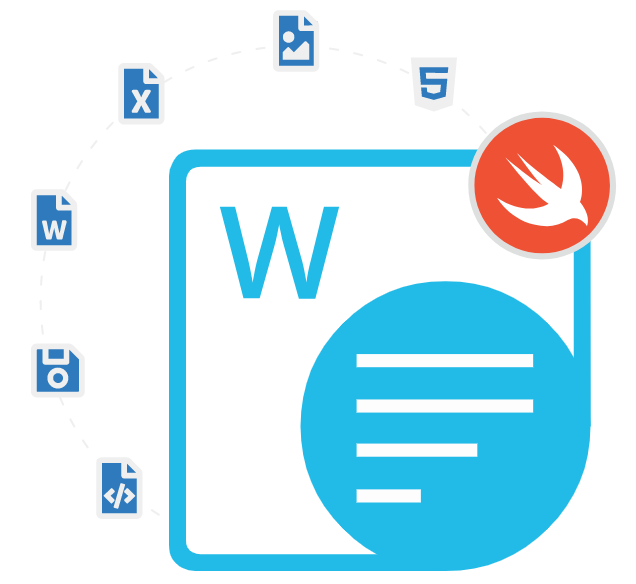
Aspose.Words Cloud Swift SDK
Swift API to Generate & Convert Word Documents
Swift REST API allows to Create, Edit, Compare, Split/Merge, Manipulate & Convert Word Processing Documents inside Swift-based Apps.
What is Aspose.Words Cloud Swift SDK?
The Aspose.Words Cloud Swift SDK is a comprehensive Swift word processing API that empowers iOS developers to seamlessly handle Word documents in cloud-based applications. With its powerful RESTful interface, you can effortlessly create Word documents in Swift, update existing files, and convert them to formats like DOC, DOT, DOCX, DOCM, DOTX, RTF, PDF, HTML, ODT, EPUB, XPS, PCL, TIFF, PNG, JPEG, BMP, SVG and many more. This versatile Swift DOCX to PDF API streamlines the way developers convert Word documents in Swift, making it ideal for apps requiring document automation and multi-format compatibility.
Built for productivity, the SDK offers everything software developers need to edit Word documents in Swift, insert text, images, and watermarks, perform mail merge, and work with tables in Word files. It also enables developers to manage headers/footers in DOCX, secure documents with passwords, and automate custom Word document generation. As a robust Swift office automation API, it abstracts complex technical tasks, allowing software developers to focus on building efficient iOS apps with Word DOCX conversion online capabilities. Whether you’re handling reports, templates, or personalized content, this SDK delivers all the tools for modern document processing in Swift.
Getting Started with Aspose.Words Cloud Swift SDK
The recommend way to install Aspose.Words Cloud Swift SDK is using CocoaPods. Please use the following command for a smooth installation.
Install Aspose.Words Cloud Swift SDK via CocoaPods
pod 'AsposeWordsCloud', '~> 23.3'
pod install
Word Documents Management via Swift API
Aspose.Words Cloud Swift SDK has included several important features for working with Word documents inside Swift cloud applications. It supports creating new Word documents from scratch as well as modifying existing Word documents. There are several other important features part of the SDK for Word document management, such as inserting images into documents, getting document properties, tracking changes in Word documents, merging/splitting existing documents, protecting Word documents, comparing multiple documents, inserting watermarks to documents, and many more. The following examples show how to use Swift code to generate new Word documents in the cloud.
How to Generate New Word Documents via Swift REST API?
import AsposeWordsCloud
let config = Configuration(clientId: "####-####-####-####-####", clientSecret: "##################");
let api = try WordsAPI(configuration: config);
let createRequest = CreateDocumentRequest(fileName: "Sample.docx");
_ = try api.createDocument(request: createRequest);
Convert Word Document to Other Formats via Swift REST API
Aspose.Words Cloud Swift SDK has included a very powerful Word Documents converter that enables software developers to convert Word documents to several other important file formats with just a couple of lines of Swift code, such as DOC, DOT, DOCX, DOCM, DOTX, DOTM, FlatOpc, RTF, PDF, HTML, ODT, OTT, TXT, EPUB, XPS, PCL, TIFF, PNG, JPEG, BMP, SVG and many more. It provides a quick and safe way for converting multiple Word files in the cloud. The following example shows how to convert Word documents to PDF file formats inside Swift applications in the cloud.
How to Convert Word Documents to PDF using Swift REST API?
import AsposeWordsCloud
let config = Configuration(clientId: "####-####-####-####-####", clientSecret: "##################");
let api = try WordsAPI(configuration: config);
let requestDocument = InputStream(url: URL(string: "Sample.docx"))!;
let convertRequest = ConvertDocumentRequest(document: requestDocument, format: "pdf");
_ = try api.convertDocument(request: convertRequest);
Insert & Manage Watermark in Word Documents via Swift API
A watermark is a very useful features of World documents that can be used to identity the documents status, manufacturer or brand information. It is placed behind the text in the Word document. Aspose.Words Cloud Swift SDK makes it easy for software developers to add watermarks inside their Word Documents and manage its properties inside their Swift applications. The API supports text as well as graphic watermarks. It supports inserting a watermark into a Word document, setting the watermark text and rotation angle, and deleting an existing watermark. The following example shows how to insert watermark image into a Word document using Swift REST API.
How to Insert Image Watermark in Word Documents via Swift REST API?
import AsposeWordsCloud
let config = Configuration(clientId: "####-####-####-####-####", clientSecret: "##################");
let api = try WordsAPI(configuration: config);
let requestDocument = InputStream(url: URL(string: "Sample.docx"))!;
let requestImageFile = InputStream(url: URL(string: "Image.png"))!;
let insertRequest = InsertWatermarkImageOnlineRequest(document: requestDocument, imageFile: requestImageFile);
_ = try api.insertWatermarkImageOnline(request: insertRequest);
Insert Headers & Footers in Word Documents in Cloud
Aspose.Words Cloud Swift SDK has included very useful features for handling Headers & Footers in Word documents inside their own Swift applications. Software developers can easily insert new headers and footers inside their Word documents, modify existing one, delete all Header/Footer objects, get a Header/Footer from Word document, link headers/footers of a section to the previous one online and many more. There following example demonstrates how software developers can insert Headers and Footers into a Word Document inside Swift applications.
How to Insert Headers and Footers into Word Documents via Swift API?
import AsposeWordsCloud
let config = Configuration(clientId: "####-####-####-####-####", clientSecret: "##################");
let api = try WordsAPI(configuration: config);
let requestDocument = InputStream(url: URL(string: "Sample.doc"))!;
let insertRequest = InsertHeaderFooterOnlineRequest(document: requestDocument, sectionPath: "", headerFooterType: "FooterEven");
_ = try api.insertHeaderFooterOnline(request: insertRequest);
